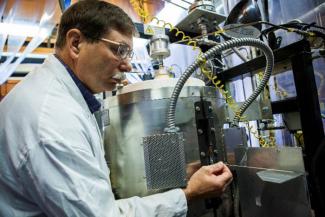The inside of today’s energy systems host some of the harshest environments anywhere on the planet, and the faults, fractures, and carbon dioxide plumes deep underground present an array of challenges for resource recovery. Sophisticated sensors help energy systems to operate more efficiently, and assist in recovering underground oil and gas. However, creating sensors that can withstand these formidable environments is a challenge. NETL is on the task.
Sensors are detectors that can measure physical quantities like temperature and pressure. The sensors convert measurements into a signal that communicates with an electronic device that is read by operators who take actions to adjust conditions if necessary.
In Power Systems
Sensors measure fuel composition, heat rates, pollutants, temperatures, pressures, and other parameters key to efficient operation in power generation systems. Fiber optic sensors are one novel approach for wireless communication in these harsh environments. Only slightly thicker than a human hair, optical fibers can transmit signals over long distances and without electromagnetic interferences - a key advantage as compared to conventional metal wires. Optical fibers also require no active electrical power at the sensing location and can reach otherwise inaccessible places by transmitting light or radiation from the fiber to a measurement device, which better facilitates their use in remote locations.
NETL researchers are using fiber optics to monitor the operating conditions inside solid oxide fuel cells (SOFCs). SOFCs are electrochemical devices that convert the chemical energy of a fuel and oxidant directly into electricity. SOFCs run on hydrogen that can be produced from fossil fuels, including coal, and they are much more efficient and environmentally benign than conventional electric power generation processes that rely on combustion. However, SOFC degradation is a key factor impeding wide-scale deployment. Fuel cells operate at temperatures around 800 degrees Celsius, and fiber optic sensors can offer new insights into the details of chemical and thermal processes occurring within the cell. This new sensing approach from NETL is being developed to work in elevated temperatures and highly reactive, hydrogen-containing environments, such as those found inside an SOFC. This successful technology development will ultimately provide information on these previously inaccessible locations and enable optimized operation with improved efficiencies.
Currently, NETL is demonstrating fiber optic sensors on SOFC applications, and this technology has potential to translate to sensors in other advanced power systems, including turbines and boilers.
In the Subsurface
The subsurface is an important location for many energy applications including natural gas production, enhanced oil recovery, and carbon storage. Monitoring conditions underground helps ensure that these applications are safe, for example mapping CO2 plumes, detecting potential release pathways like fractures or faults, and protecting groundwater.
Traditionally, such monitoring work required sample collection and analysis. But a new sensor from NETL offers a more convenient method for a variety of applications.
NETL’s laser induced breakdown spectroscopy (LIBS) system enables continuous subsurface environmental monitoring of gases, liquids, and solids without sample collection or preparation. The device uses a special type of laser that provides information on the types of elements present in the area being monitored. The LIBS sensor can be used for monitoring air, water, and soil and is able to accurately detect any element in low concentrations. In carbon storage applications, the LIBS sensor can be deployed in test wells to take baseline measurements and get a clearer picture of chemical changes occurring during injection, and it can take measurements of the fluids that CO2 displaces as it moves underground. In clean water applications, the LIBS sensor can provide detailed elemental information on what is in your water and whether it is safe to drink. In oil and gas production, the sensor can assess downhole fluid chemistry before and after hydrofracturing to ensure these operations do not harm the environment.
With no samples to collect, the novel sensor saves time and money on collection and analysis while providing a high degree of accuracy.
In Pipelines
Pipelines are used to transmit natural gas and supercritical CO2 (pressurized CO2 in a liquid state) across the country. Advanced sensors technology can enhance the safety and reliability of this important infrastructure. For instance, corrosion, such as rust, can deteriorate the pipeline material. Over time, this may lead to failure of the material and pipeline. Current methods for inspecting for corrosion requires the transmission of these much-needed fluids be interrupted for days, hindering efficiency. A novel sensor from NETL provides an alternative, saving money with less down time and enhance safety.
Corrosion in these systems is an electrochemical process in which a corroding metal produces electrons consumed by the surrounding environment. Therefore, the rate of electron flow to or from a corroding surface is a measure of corrosion rate. NETL’s electrochemical sensor takes advantage of this process to measure how fast corrosion is occurring and how conducive to corrosion is the surrounding environment. The new sensor can measure, non-destructively and in real time, the rate of corrosion and characterize the environment in the pipeline so that corrosion may be prevented. The sensor also offers the unique advantage of being able to operate in high-pressure environments.
From pipelines to power stations, NETL is developing sophisticated sensors to see and hear inside the world’s harshest environments. These advanced sensors will enable next-generation energy systems to operate at optimal efficiency and safety, enabling our nation to power prosperity on home-grown energy resources with sounds environmental stewardship.




